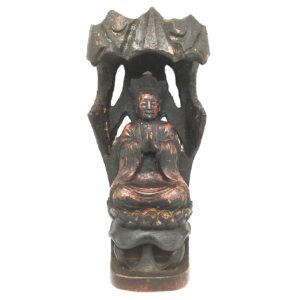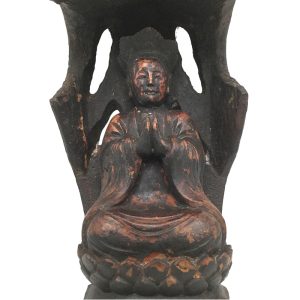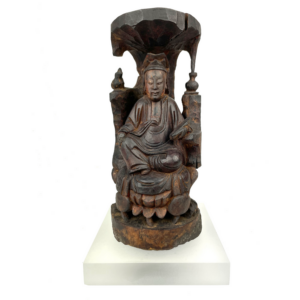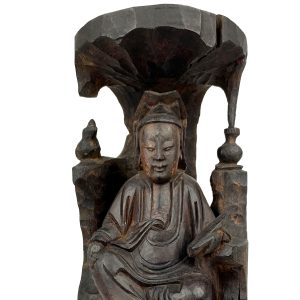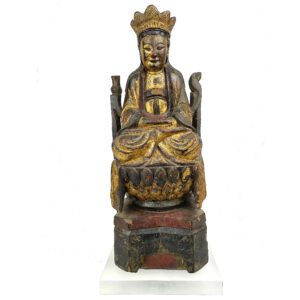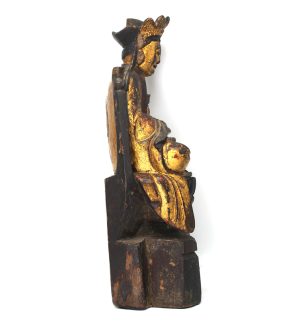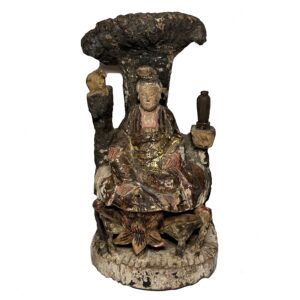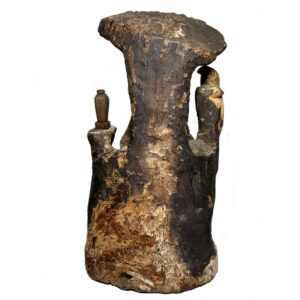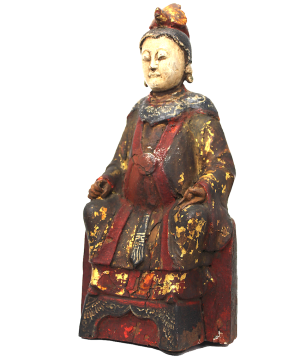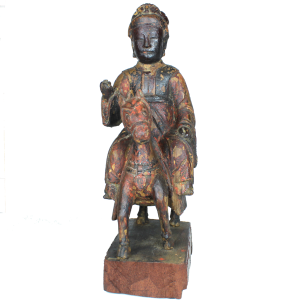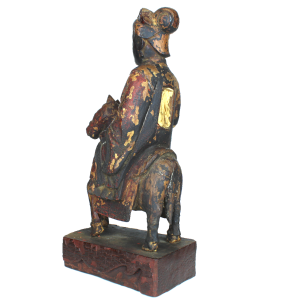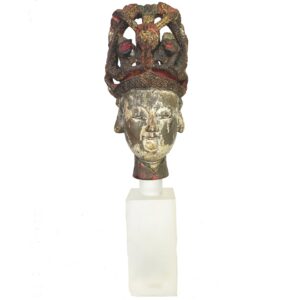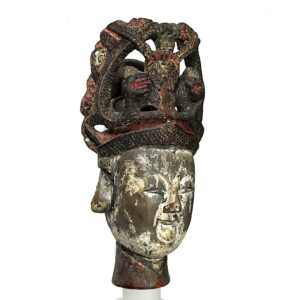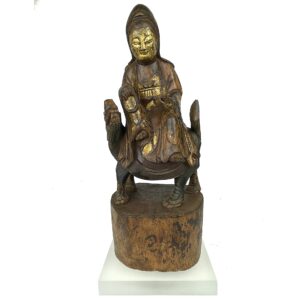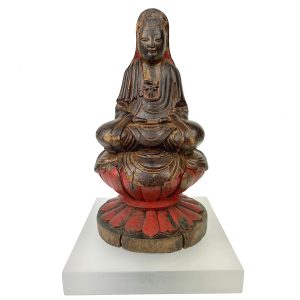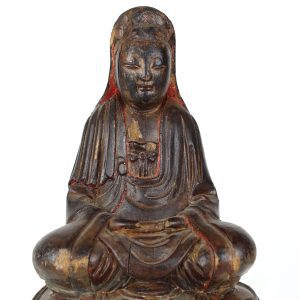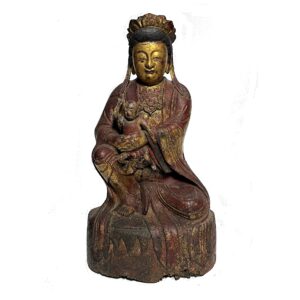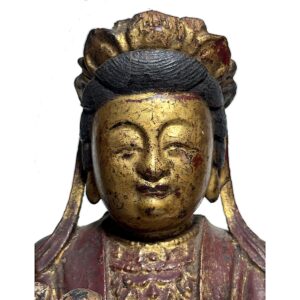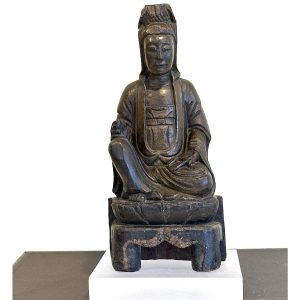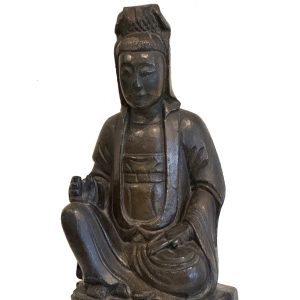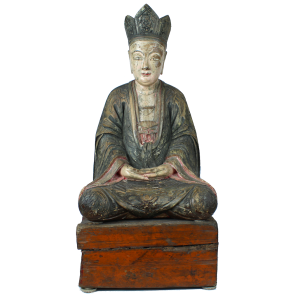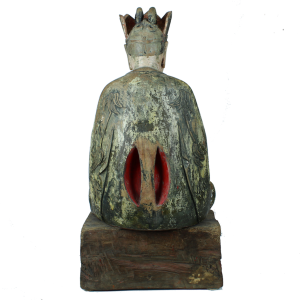Showing 13–24 of 36 results
-
Sale!


$450.00 Original price was: $450.00.$325.00Current price is: $325.00.
H: 11.75″ W: 5.25″ D: 4.75 ” | Free shipping within continental us
Provincial Nanhai Guanyin palms at heart in anjali mudra, a mudra of offering rarely used for Nanhai Guanyin. On lotus throne at Tidal Cave on Putuo under a craggy rock outcrop with pierced openwork.
-
Sale!


$850.00 Original price was: $850.00.$625.00Current price is: $625.00.
H: 9.5 ” D: 4.5″ | FREE SHIPPING WITHIN CONTINENTAL U.S.
Rare provincial white hooded Nanhai Guanyin in Cave below openwork draped moss and barbed rocks holding precious scrolls, with vial and parrot. Open lotuses symbolize her purity and enlightenment, closed lotuses potential for enlightenment of others.
-
Sale!


$1,450.00 Original price was: $1,450.00.$1,150.00Current price is: $1,150.00.
H: 15.5″ W: 6″ D: 5.25″ | CALL 213-568-3030 OR EMAIL VANISHINGARTS213@GMAIL/COM for shipping information
Elegant Guanyin in meditation, gilt covered with five-lobed crown. Sacred vial on her right and parrot on left. Guanyins statues with symbols in this condition are rare and impart a feeling of serenity to the environment around them.
-
Sale!


$595.00 Original price was: $595.00.$525.00Current price is: $525.00.
H: 9.75″ W: 5″ D: 4.5″ | FREE SHIPPING within continental u.s.
Nanhai Guanyin in her Cave in lalitsana, below draped moss arch holding a scrolls, next to vial of humanity’s tears and parrot, her constant companion. Small Nanhai images with these symbols are very rare.
-
Sale!


$585.00 Original price was: $585.00.$395.00Current price is: $395.00.
H: 11.5″ W: 5.3″ D: 4.2″ | FREE SHIPPING WITHIN CONTINENTAL U.S.
Provincial carving with iconic phoenix headdress, hands in karana mudra to cast out demons, negative energy and purify spaces. Image was on home altar and consecrated with a sealed cover.
-
Sale!


$625.00 Original price was: $625.00.$495.00Current price is: $495.00.
H: 14.75″ W: 5.25″ D: 6.8″ | FREE SHIPPING WITHIN CONTINENTAL U.S.
By making the Queen Mother larger than her horse and adorning it with decorative accessories – wide blanket, prominent head gear, double rowed harness, decorative medallion – this provincial artist emphasizes her power as Tao goddess of life, fertility and granting immortality.
-
Sale!


$785.00 Original price was: $785.00.$495.00Current price is: $495.00.
Ht: 17” W: 4.25” D: 4.5” | FREE SHIPPING WITHIN CONTINENTAL U.S.
Very rare depiction of Queen Mother of the West puppet head wearing elaborate headdress with outstretched tortoise legs atop a phoenix, reflecting early shamanism rites of turtle shell divination. Mounted on acrylic base.
-
Sale!


$725.00 Original price was: $725.00.$585.00Current price is: $585.00.
H: 15.125” W: 6” D: 5” | FREE SHIPPING within Continental U.S.
Rare provincial carving of Guanyin in lalitsana clasping a rosary on a mythical Hǒu that symbolizes righteousness, morality and ushers in peace and prosperity. Small yet powerful, consecrated and mounted on Acrylic base.
-
Sale!


$495.00 Original price was: $495.00.$395.00Current price is: $395.00.
H: 8.675″ Dia: 4.5″ | Free SHIPPING WITHIN CONTINENTAL U.S.
Delicate white robed Guanyin in meditation on radiating lotus throne. Provincial humble, modest, relatable, yet beautiful matronly figure.
-
Sale!


$2,650.00 Original price was: $2,650.00.$1,975.00Current price is: $1,975.00.
H: 14.5” W: 8.25” D: 5” | CALL 213-568-3030 OR EMAIL [email protected] FOR SHIPPING.
Rare and beautiful provincial Songzi Guanyin is modest, compassionate and humble with lotus leaf crown, unadorned robe and pedestal with simple leaves. Her baby resembles the infant Buddha. Was probably on a home altar of wealthy couple desiring a (male) baby.
-
Sale!


$785.00 Original price was: $785.00.$625.00Current price is: $625.00.
H: 10.75″ W: 5.5″ D: 4.5″ | FREE SHIPPING IN CONTINENTAL U.S.
White clad Guanyin in royal ease and karana mudra to expel evil, remove problems and rid sickness or other negativities rarely used for Guanyin. Consecrated for home altar use.
-
Sale!


$4,450.00 Original price was: $4,450.00.$3,500.00Current price is: $3,500.00.
Ht: 27.5” W:13.5: D: 10.25” | CALL 213-568-3030 FOR SHIPPING QUOTE OR EMAIL US AT [email protected]
Magnificent example of fine provincial Buddhist statues. Made to be seen in the round, her garment has delicate incised leaves and leaf motifs on front, back, and sleeves. High pointed crown with the Five Tantric Dhyani Buddhas, rare in provincial Guanyins.
End of content
End of content

